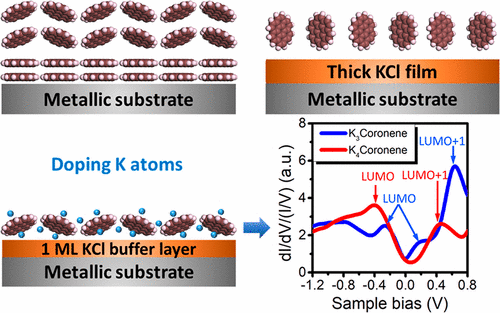当前位置:
X-MOL 学术
›
J. Phys. Chem. B
›
论文详情
Our official English website, www.x-mol.net, welcomes your
feedback! (Note: you will need to create a separate account there.)
Growth Behavior of Pristine and Potassium Doped Coronene Thin Films on Substrates with Tuned Coupling Strength
The Journal of Physical Chemistry B ( IF 2.8 ) Pub Date : 2017-09-19 00:00:00 , DOI: 10.1021/acs.jpcb.7b05140 Chaoqiang Xu 1 , Yande Que 1 , Yuan Zhuang 1 , Zhijun Lin 1 , Xuefeng Wu 1, 2 , Kedong Wang 2 , Xudong Xiao 1
The Journal of Physical Chemistry B ( IF 2.8 ) Pub Date : 2017-09-19 00:00:00 , DOI: 10.1021/acs.jpcb.7b05140 Chaoqiang Xu 1 , Yande Que 1 , Yuan Zhuang 1 , Zhijun Lin 1 , Xuefeng Wu 1, 2 , Kedong Wang 2 , Xudong Xiao 1
Affiliation

|
The growth of polycyclic aromatic hydrocarbon (PAH) molecular coronene film on various substrates and the subsequent doping of potassium under ultrahigh vacuum (UHV) conditions have been systematically investigated by low-temperature scanning tunneling microscopy and spectroscopy (STM/STS). The crystalline structures and molecular orientations of coronene thin films are both thickness-dependent and substrate-sensitive due to the competition between molecule–substrate interaction and intermolecular interaction. In mono- or bilayer films, coronene molecules are flat-lying on the surface with hexagonal lattice, whereas in multilayer films, the topmost molecules are in a standing-up but tilted configuration with rectangular lattice. In particular, a 2 × 1 superstructure with respect to that of bulk coronene is formed on thick KCl film. Furthermore, we have studied the potassium doped coronene monolayer and multilayer on Ag(100) and KCl/Ag(100) surface. For K-doped coronene monolayer, at certain doping ratio x = 3, the lowest unoccupied molecular orbital (LUMO) of coronene film moves to the Fermi level, and a splitting of the LUMO state is observed. Increased potassium doping would result in a filled LUMO state below the Fermi level. By contrast, no well-ordered structures are obtained in the K-doped coronene multilayers which are vulnerable to rather moderate annealing processes owing to their relatively weak bonding with the supporting substrates, implying a big challenge of growth of PAH thick films in vacuum. The differences in the crystal structures of coronene thin films compared with that in bulk crystals might shed insight on the controversies in the experimental results on the electronic properties of alkali-metal-doped PAHs.
中文翻译:

可调耦合强度的基体上原始和钾掺杂的ron烯薄膜的生长行为
通过低温扫描隧道显微镜和光谱法(STM / STS),系统地研究了多环芳烃(PAH)分子烯膜在各种基底上的生长以及随后在超高真空(UHV)条件下对钾的掺杂。由于分子-底物相互作用和分子间相互作用之间的竞争,冠冕薄膜的晶体结构和分子取向均取决于厚度且对底物敏感。在单层或双层膜中,冠冕分子平铺在具有六边形晶格的表面上,而在多层膜中,最顶层的分子处于直立但倾斜的结构中,并具有矩形晶格。特别地,在厚的KCl膜上形成了相对于本体of烯的2×1的上部结构。此外,我们已经研究了Ag(100)和KCl / Ag(100)表面上钾掺杂的异戊二烯单层和多层。对于K掺杂的ron烯单层,在一定的掺杂比下x= 3,冠膜的最低未占据分子轨道(LUMO)移动到费米能级,并且观察到LUMO状态分裂。钾掺杂的增加将导致在费米能级以下的LUMO充满态。相比之下,在K掺杂的冠冕烯多层中没有获得有序的结构,由于其与支撑衬底的相对较弱的结合而易于进行相当适度的退火过程,这意味着在真空中生长PAH厚膜的巨大挑战。与大块晶体相比,日冕薄膜的晶体结构的差异可能使人们对碱金属掺杂的PAHs的电子性能的实验结果存在争议。
更新日期:2017-09-19
中文翻译:

可调耦合强度的基体上原始和钾掺杂的ron烯薄膜的生长行为
通过低温扫描隧道显微镜和光谱法(STM / STS),系统地研究了多环芳烃(PAH)分子烯膜在各种基底上的生长以及随后在超高真空(UHV)条件下对钾的掺杂。由于分子-底物相互作用和分子间相互作用之间的竞争,冠冕薄膜的晶体结构和分子取向均取决于厚度且对底物敏感。在单层或双层膜中,冠冕分子平铺在具有六边形晶格的表面上,而在多层膜中,最顶层的分子处于直立但倾斜的结构中,并具有矩形晶格。特别地,在厚的KCl膜上形成了相对于本体of烯的2×1的上部结构。此外,我们已经研究了Ag(100)和KCl / Ag(100)表面上钾掺杂的异戊二烯单层和多层。对于K掺杂的ron烯单层,在一定的掺杂比下x= 3,冠膜的最低未占据分子轨道(LUMO)移动到费米能级,并且观察到LUMO状态分裂。钾掺杂的增加将导致在费米能级以下的LUMO充满态。相比之下,在K掺杂的冠冕烯多层中没有获得有序的结构,由于其与支撑衬底的相对较弱的结合而易于进行相当适度的退火过程,这意味着在真空中生长PAH厚膜的巨大挑战。与大块晶体相比,日冕薄膜的晶体结构的差异可能使人们对碱金属掺杂的PAHs的电子性能的实验结果存在争议。











































 京公网安备 11010802027423号
京公网安备 11010802027423号